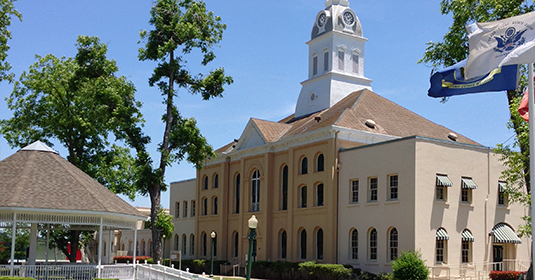County Seat: Jasper • County Population: 35,710 (2010 US Census)
County Judge: Mark Allen
County Commissioners:
- Precinct 1: Charles Shofner
- Precinct 2: Roy Parker
- Precinct 3: Willie Stark
- Precinct 4: Vance Moss
The Jasper County Courthouse was completed in 1889 and listed on the National Register of Historic Places in 1984. The courthouse was designed by Eugene T. Heiner in an Italianate style with a clock tower, which was removed in 1957. The temple of justice was expanded and stuccoed in 1934, giving it a Neoclassical look. The county completed another courthouse addition in 1960.
The initial Jasper County Courthouse was actually a crude log hut that included two rooms. Historians are not sure who built the structure or when it was completed, as it was destroyed by a fire in October 1849. The second county capitol was erected in 1853, followed by the third and final courthouse that stands today.
One of the original 23 Texas counties, Jasper has a deep history of early pioneers forging independence in a new land. In fact, the county was named for Sgt. William Jasper, a member of Francis Marion’s regiment during the U.S. Revolution.
The area is graced with beautiful historic structures, such as the Swann Hotel built in 1901. The restored building now serves as a bed and breakfast. The Belle-Jim Bed and Breakfast and Restaurant was completed in 1910 and has been refurbished to its original condition, as well. Debney House on Main Street was built in 1853 by R. C. McFarland and is the oldest residence in the city of Jasper. The Jasper County Historical Commission is housed in one of the county’s old jail buildings.
The communities of Evadale, Buna and Kirbyville feature large, lush green pastures with cattle grazing bordered by the great pine forests that cover most of Jasper County. Hiking and biking trails wind through the woods, several of which lead down to the Neches and Angelina rivers that flow through Jasper County.
Lake B.A. Steinhagen lies to the west of Jasper County along U.S. 190; a trip further north along U.S. 96 leads to Lake Sam Rayburn, the largest lake in Texas that does not border another state. Due to the pleasant climate, Lake Sam Rayburn offers the opportunity for fishing recreation and tournaments literally year-round, accompanied by plentiful boat launches, camping areas, hiking trails, restaurants and hotels.










